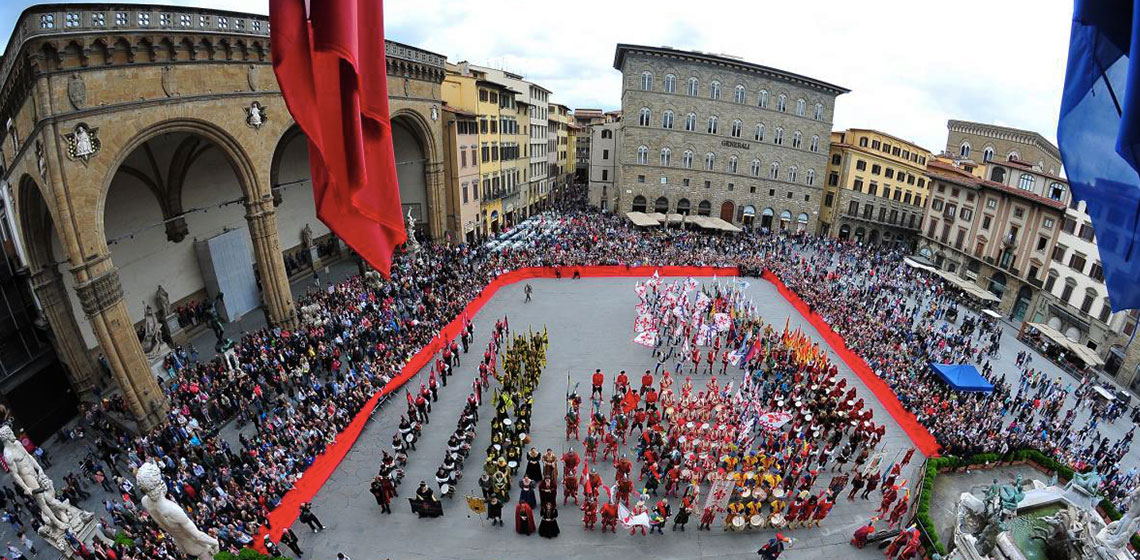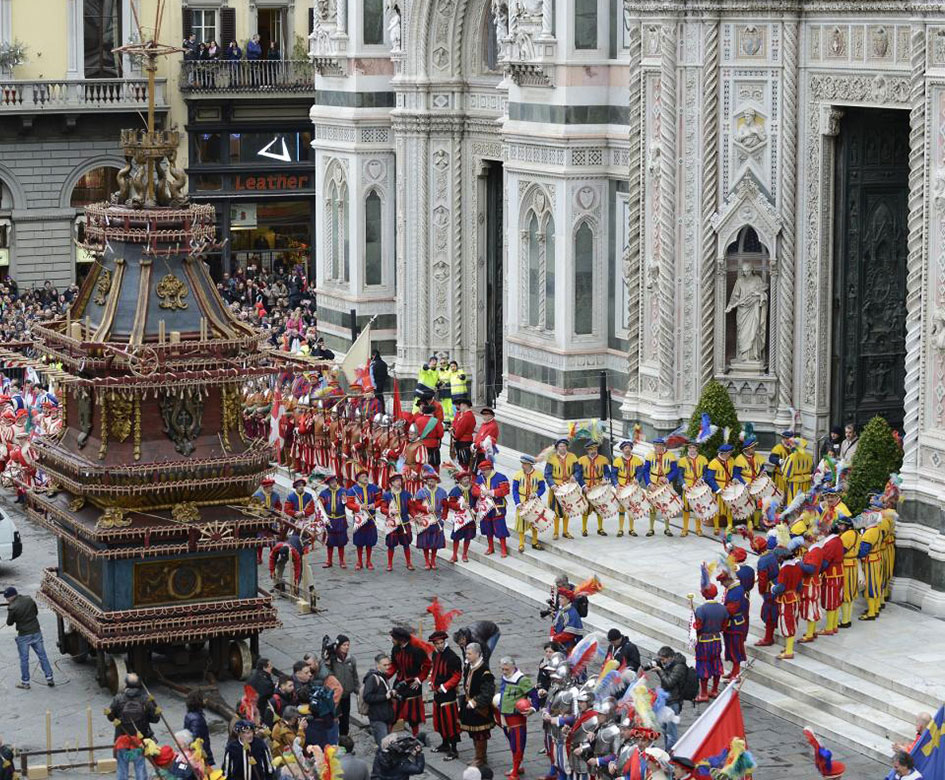
Traditional Florentine holidays: do you know them all? [Chapter 1]
Dive headfirst into Florentine traditions: the city festivities celebrated year after year.
Every city enjoys their share of festivities and Florence does, too.
Florentines, as their reputation suggests, proudly exult their rich heritage and traditions. If you find yourself wandering through Florence’s narrow streets during these days, you might bump into a folkloric parade trailed by the renowned Uffizi Flag Throwers.
Mark your calendar with the following holidays:
Saint Zenobius – January 26
Ever heard of the column of Saint Zenobius (and know where it is)?
You’ll find this structure in front of the northern door of the San Giovanni Baptistery in Piazza Duomo, the very spot where the city celebrates Saint Zenobius every year.
The granite column is crowned with an iron tree and cross, positioned where a miracle took place centuries ago, or so legend says.
On January 26, 429, during the transportation of the saint’s relics from the San Lorenzo Basilica to the Santa Reparata Cathedral (beneath today’s Florence Cathedral), a dry elm tree suddenly regained life after accidentally touching Saint Zenobius’ sarcophagus.
To celebrate the miracle, a floral tribute is brought to the column on January 26, an event featuring the city authorities and the Historic Procession. The remains of the Santa Reparata Cathedral are still visible today in the Florence Cathedral Crypt, accessed using the cumulative ticket of the Opera del Duomo Museum.
Electress of the Palatinate – February 18
Anna Maria Luisa de’ Medici (also known as Electress of the Palatinate, as she was the wife of the Prince of Saxony, Elector Palatine of the Rhine, the prince elected by the King of Germany) was a key figure in Florentine history: thanks to her, the city’s treasures are here to stay.
As the last descendant of the Grand Ducal Medici family, Maria Luisa was responsible for the so-called “Family Pact,” that is, a legal document that bound the wealth of the Medici collection (spanning various centuries) to the Grand Duchy of Tuscany: a binding agreement securing Medici assets before the end of their rule.
In her honor, the City of Florence celebrates the anniversary of her death with a full day of free entry to Florence’s Civic Museums. Follow the Historic Procession of the Republic of Florence as they parade through the city streets and adorn her tomb with flowers inside the Medici Chapels.
To learn more about this fascinating piece of Florentine history, don’t miss a performance of The Medici Dynasty Show.
Florentine New Year – March 25
Florence celebrates the New Year twice: on January 1 and March 25.
In medieval times, the civic calendar began on March 25, as this was the date of the Annunciation to the Blessed Virgin and thus the conception of Christ (the date exactly 9 months before Christmas).
For the holiday, Florentines would assemble in the Santissima Annunziata Basilica to pray.
In 1582, the Gregorian calendar was officially adopted, marking January 1 as the beginning of the year.
Yet Florentines, proud as they were, continued celebrating the New Year on March 25 – at least until 1749, when Grand Duke Francis III of House Lorraine put an end to the tradition.
Despite his efforts, the date became an institutionalized city holiday, today called the Florentine New Year. The festivity is also celebrated with the city’s Historic Procession, which winds its way from the Palagio di Parte Guelfa, to the Santissima Annunziata Basilica.
Explosion of the Cart – Easter Sunday
On the morning of Easter Sunday, witness a celebration that merges the sacred with the profane: the Explosion of the Cart.
The Historic Procession of the Republic of Florence, with its flag throwers, drummer boys and characters in traditional attire, trail behind the cart pulled by four white oxen (called the “Brindellone”).
The procession begins in piazzale del Prato and reaches Piazza Duomo, where the cart is positioned in front of the cathedral. At the conclusion of mass, a cable is set connecting the cart to a column inside the church, and to the sound of the first notes of Gloria in Excelsis Deo, the Bishop launches a dove-shaped rocket (la “Colombina”) down the cable, initiating the show.
The Explosion of the Cart symbolizes the distribution of the Holy Fire to the entire city; the tradition dates to before the First Crusade and recalls Pazzino dei Pazzi’s return to Florence from Jerusalem, who brought back three stone fragments from Christ’s Holy Sepulcher.
The stones were used to ignite a fire, which was then distributed to reignite the hearths of Florentine families: this event set the stage for the longstanding tradition of distributing the Holy Fire.

Trofeo Marzocco – May 1
On May 1, Florence celebrates yet another tradition with centuries-old origins, a colorful and fascinating game tied to both history and… flags: the Trofeo Marzocco.
This unusual tournament hands over the reins to historic flag throwing teams from all over Italy (usually four), who challenge each other’s talent and abilities in the incredible setting of Piazza della Signoria. The event’s name dates to the Republic of Florence, where the “marzocco” (lion), was a symbol of the people’s power (you’ll find Donatello’s marzocco in the Museo del Bargello, whose copy is located in front of Palazzo Vecchio).
Throughout history, the animal often symbolized power and wealth and was thus a widely diffused emblem.
This flag throwing tournament wouldn’t be complete without the city’s Historic Procession, which meanders its way through the historic center before reaching Piazza della Signoria, where the tournament finally begins.
To be continued…






 All the services are provided by local merchants
All the services are provided by local merchants By using this site you support Florence
By using this site you support Florence We offer products with high-quality standards
We offer products with high-quality standards You stay sustainable
You stay sustainable It's a 100% trustworthy website
It's a 100% trustworthy website